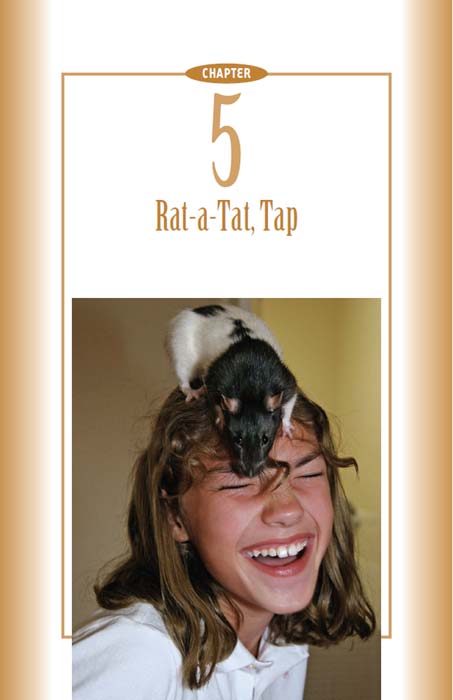

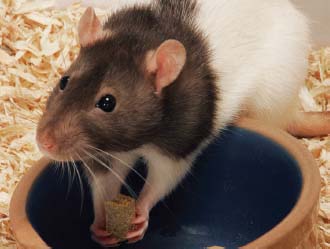
For added ease in training, sessions should begin at mealtime.
NOW WE’VE REACHED THE HEART OF THIS BOOK: RAT training. You’re well versed in essential rat care and have taken the necessary steps to ensure that Ben and Ira are healthy, happy, and ready to learn. Remember that a stressed or ill rat is unable to tolerate any level of strain, even if it is a fun educational game.
To successfully train your Ben or Ira, you will need to use the daily feeding sessions as training sessions. While some rats may eventually perform for the reward of freedom or play, they rarely work for human praise. Few, if any, will initially work for play. You will need to rely on a fail-safe motivator. Food will do it every time.
Reward-based learning is a positive means of developing fast responses, creating an enjoyable environment in which your rat is willing to interact, eager to learn, and happy to spend time with you. Ben and Ira will have something to look forward to each day. A working rat is healthier, both mentally and physically.
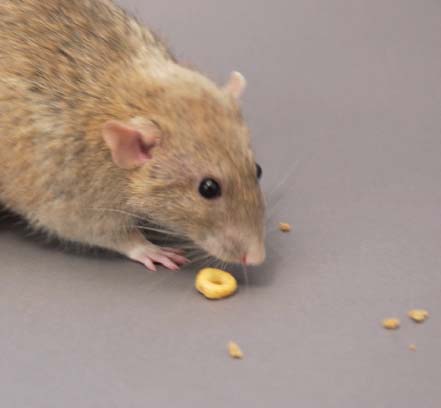
Placing treats in the training area quickly acclimates your student to the space.
Prepare for training by deciding what type of food reward you will use. The choice is up to you: Ben’s regular cubes, fresh vegetables, or yogurt treats. You don’t have to use the same food every training session. In fact, the more you vary the reward, the more your rat will remain interested in obtaining it.
I’ve always done a quick morning training session by having my rats come when called and rise up on their hind legs to receive their food cube. One each is all they need. Sometimes I vary the routine by having them traverse obstacles along the way, such as an A-frame, jumps, and tunnels. Rat agility!
In the evenings, my rats earn their yogurt treats by following me in their exercise ball or learning new tricks. Often, I just place the treats throughout their exercise areas so that they get to have treasure hunts. This simulates natural environments and gives them loads of exercise as well.
If you have been free feeding Ben to this point (allowing him unlimited access to food), you might need to either use a very high-value reward or food deprive him for twelve to twenty-four hours prior to initiating the training. Usually, using a high-value food is sufficient, but some rats can be very finicky and prefer their cubes or seeds so much that it is difficult to substitute anything not part of their normal diet as a reward. You may not discover this until you begin the training process. Lackluster responses will be most pronounced in an overweight rat rescued from a shelter. This rat was obviously free fed for a long time, and his obesity makes him very lethargic. It might take a while for him to decide to move around a bit to eat.
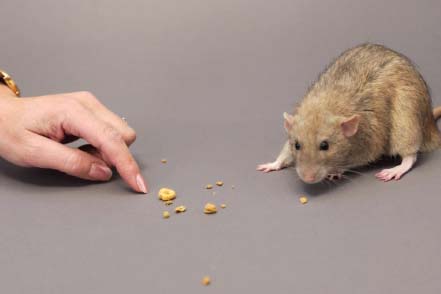
The tapping finger signals that food is available.
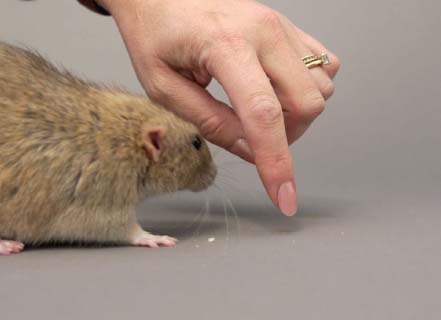
This rat has learned to come to a tap without needing to receive food.
You can begin by working Ben and Ira in their cage or on an uncluttered table in a quiet room. The less distraction, the better, as you need your rat to concentrate on learning, not playing or eating something other than a treat that was earned. If you are going to be using apparatuses such as tunnels, hoops, and stools, allow Ben and Ira to explore the structures for a while prior to the training session. However, don’t start working with an apparatus until your rat understands some basics such as come and follow.
The surface of the training area should be nonslippery and easy to clean. Rats rarely contain their waste and will relieve themselves wherever they happen to be. An easy-to-clean surface will allow you to train Ben and Ira with little interruption as you quickly wipe off the waste.
Rats may be frightened by unfamiliar people but are rarely fearful of new objects. If you find that your rat shows any hesitation nearing an object used in training, however, put a morsel of food on it. Once Ben associates an object with food, he will be back for more. Rats never forget where food can be found. They may be rodents, but they have superior intelligence, pattern memory, and adaptability; that is why they are such a successful species all over the world.
Noting that rats have excellent pattern memory brings me to the next point: vary the training exercises so that you are teaching Ben and Ira to respond to your cues, not to a specific pattern. If you use an apparatus, move it around from training session to training session. When teaching your rat to come to you, don’t always stand or sit in the same place. Move to different areas. This will aid in the development of your pet rat’s brain instead of merely teaching a pattern. Any rodent can do a maze. An exceptional rodent actually understands how to communicate with and respond to you, process new patterns, and solve new problems.
If you plan to conduct training sessions in a specific area, begin using this area for feeding times. Before you know it, Ben and Ira will be running from their cages directly to the training area, ready to go.
You must lead your rat into an appropriate response. Therefore, you must be able to let Ben and Ira know the moment they are performing correctly. What happens when you see your rat doing something right but can’t get the words out in time? By the time Ben and Ira move, it’s too late. Timing of a reward is crucial. The behavior expressed at the moment you reward is the behavior that will be repeated.
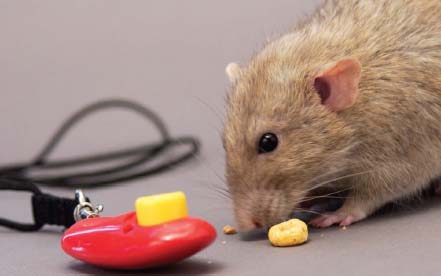
A clicker instantly marks the moment your rat performs as you wish.
Once you have chosen the ideal training treat and training location, you’re ready to teach Ben and Ira the meaning of a reinforcing marker. Rats are some of the first creatures ever tested to respond to positive reinforcement training markers. The marker can be any specific sound paired with a reward. The easiest tool for this is a clicker.
A clicker is a small plastic box with a metal tongue that, when depressed and released, makes a clicking sound. Each clicker produces a distinct sound. This tool can be easily operated with your thumb and a couple of fingers to stabilize it, leaving your other hand free to lure and cue your rat during training.
When you are training, I suggest that you reward Ben with tiny morsels or he will quickly fill up and no longer have an interest in training. Another drawback to using large morsels is that your rat will spend a lot of time eating, taking away from your precious training time allotments. (Few of us can spend the entire day training our rats.)
As most animals learn best when they know what to expect, be consistent. Present a new idea in a simple manner. The moment Ben and Ira respond, click and reward. Again, timing is crucial. An animal only acknowledges a correct action when you mark the moment of that action. That’s why using a clicker is useful, as it is far easier, simpler, and faster to press your thumb than to form words or tap a finger on a hard surface. Keep in mind that rats don’t care as much about your voice as a dog or cat might. But they do recognize specific sounds that bring rewards or result in something negative.
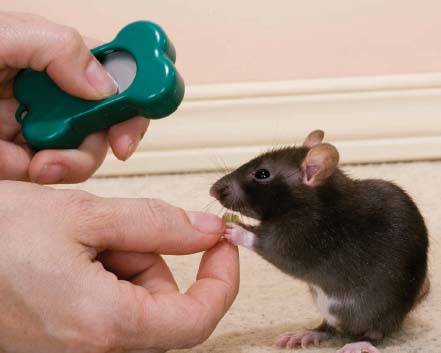
Pair the sound of the clicker with the giving of a treat to get your point across. The clicker, shown here only for illustration, should be out of rat sight.
Do not hold the clicker near your rat or point it at him like a television remote control. Ira’s hearing is actually quite good and he’ll be wondering what you’re offering if you point the clicker at him. Is it another toy? Maybe food? Keep the clicker either at your side or behind your back. There’s no need for your rat to see where the noise originates.
Condition your rat to the clicker in the following manner:
1. Show your rat the treat.
2. When your rat sniffs at the food, click and allow him to eat the food.
3. Repeat at least five times.
Your pet rat is sure to identify the clicking sound with the dispensing of food within a very short time. You’ll know for sure when you see his little whiskers and nose quivering as he requests more food.
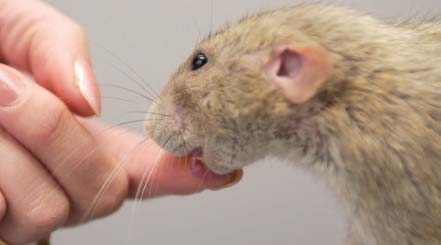
Teach your rat to target on your hand by placing some food on a finger—but be careful.
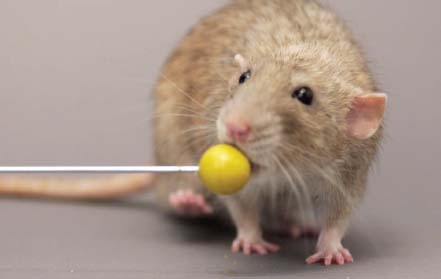
Baby food smeared on the target stick expedites teaching your rat to target.
Now you can start luring him with the food.
1. Allow your rat to sniff the food, but don’t give it to him.
2. Move it slightly to one side.
3. When your rat moves his head toward the food morsel, click and give him the food.
Repeat the luring sequence in all directions. Up, down, left, and right. Don’t make Ben or Ira do more than move their heads to look at the food. This is a very important first step, and you don’t want to cause any anxiety about chasing after food morsels. Teach your rats that they merely have to follow the direction of the food to earn it.
This step will further reinforce the clicking sound with the delivery of a reward.
After only a couple training sessions, Ben and Ira will have a complete understanding of the meaning of the click.
As you lure Ben and Ira into any number of new behaviors, you are using specific visual cues with each action. Your rat is learning that following these movements will be very rewarding. Thus, your pet rat is being reinforced—rewarded—by following the cues.
It is a good idea to write down all of the different tricks and behaviors you will be teaching your rat. Each behavior will need to be paired with a specific cue in order for the cue to remain a clear communicator. I recommend the use of hand gestures, a target stick, or both.
A target stick should have some means of holding a food morsel on the end. You can make a simple target stick by taping a small spoon or fork to a quarter-inch-diameter dowel or an old wooden spoon. For overzealous rats who love their lab cubes, a pair of tongs works very well, as you can cue and reward without the risk of getting scraped by a tooth. Along the way, you’ll be able to teach your rat how to use his forepaws instead of his teeth to take the food. This will make the reward process far less stressful, as most people tend to hesitate or unconsciously pull away after receiving a rat bite, no matter how accidental. Rats generally only bite when angered or frightened, and this rarely occurs during a positive training experience. But as the saying goes, once bitten, twice shy; this will make the training process less enjoyable, so you might want to take precautions.
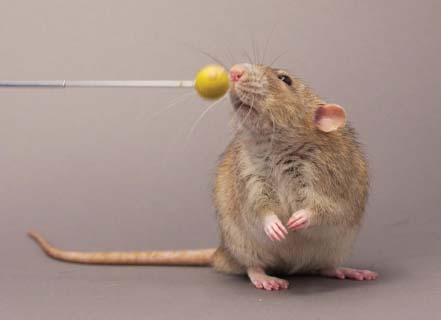
Hold the target stick near your rat’s head so he looks upward.
There are two main cues that can branch off into more complex behaviors: the tap and the lure. The tap cues the rat to come to you. The lure can teach Ben and Ira to go over, onto, and through obstacles; turn in any direction; or touch an object.
The tapping cue is one of the best reinforcers, as your rat learns that coming to you brings food and attention rewards. Thus, you’ll get a terrifically positive response to the tap.
Once Ben and Ira understand that the presence of the target stick means that food can be easily obtained, it too becomes a positive cue.
THE COME-TO-A-TAP
The best first behavior you teach your rat is to come to you when you call. As he doesn’t yet understand your words, you cannot rely on the come command to have any meaning.
If you have already worked on the clicker preparations, Ben and Ira will understand moving toward a food morsel and receiving the reward. The come exercise is merely an extension of the head movement-reward game.
Now Ben and Ira understand that your tap means they will be rewarded for coming. You can use this basic response for almost anything from traversing apparatuses to following you while in the plastic exercise ball. The come-to-a-tap is the basis for all other rodent work.
LURING
When training with a lure, it is best to use a high-value reward such as a yogurt treat, pieces of fruit, or cheese, all foods that are certain to grab your rat by the taste buds. An attentive rat is one that can be lured over and through anything. This means of controlling direction has unlimited possibilities.
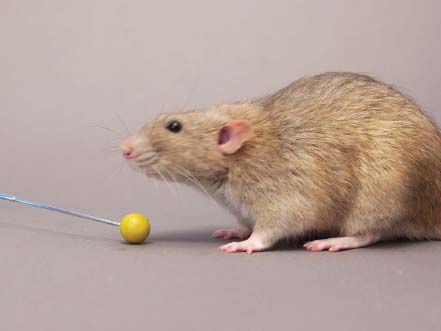
The rat will soon associate the target stick with rewards.
Let’s first teach Ben and Ira how to follow the lure.
To be certain that Ben and Ira have a good idea of what it means to go to the target stick, touch it, and get a click with reward, proceed with the following test:
TEACH YOUR RAT TO GO INSIDE THE PLASTIC BALL
1. Place the ball in a secure location where it cannot roll around if your rat should place his foot on it.
2. Put a piece of food in the ball.
3. Place your rat nearby so that he can smell the food.
4. When your rat enters the ball, click with your clicker, and allow the rat to eat the food morsel.
5. Let your rat exit on his own. After he exits, repeat steps one through four.
Within a short time Ben and Ira will be going into the ball to see if it holds treats.
The next phase of this exercise is to have your rat enter the ball without being lured by the treats. As Ben and Ira have learned that the ball contains food, there will be a very quick response as they will eagerly enter the ball as soon as it’s presented.
1. Place the ball in the same nonrolling position as before.
2. Allow your rat to approach.
3. When your rat enters the ball, click and give the rat a reward after he is inside.
4. Repeat this a few times until it is well learned.
Now we add the ball movement. Up to now we made sure that the ball was secure and nonmoving. However, if you want your rat to go into the ball when you aren’t holding it, he must accept the fact that it will move around when he presses against the edge.
The behavior markers are the same as with the previous exercises, but I suggest you start with the first exercise of baiting Ben and Ira into the ball, as the rats must have great incentive to enter a moving room. Once they are comfortable with this, you will find they’ll walk right on in of their own accord and await their marker and reward.
This process can take anywhere from one training session to a week of training sessions. Resist the temptation to force your rat into this closed-in environment as he’ll immediately want to leave instead of learn why you want him inside. Rats work far more efficiently if they believe their behavior is voluntary.
Once you have Ben and Ira acclimated to the rolling plastic ball, close the top. Do so only briefly. After a couple of seconds, click, open the top, and give your rat a reward. Gradually increase the amount of time you keep the ball closed. This will acclimate your pet rat to remaining inside without causing panic.
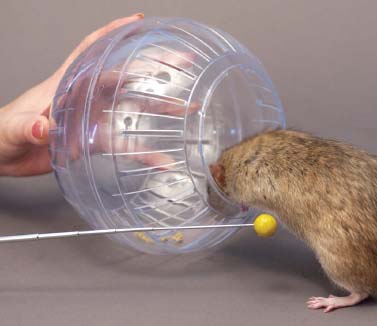
Placing food around the entrance to the ball will quickly teach your rat that the ball’s a fun place to be.
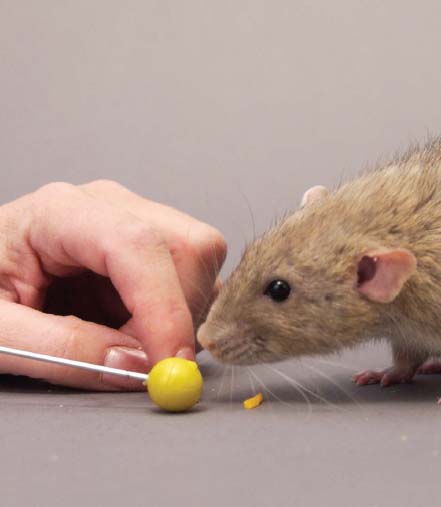
Tapping next to the food and target stick teaches the rat that the stick is also a food dispenser.
As you repeat this exercise, moving the target to different locations, gradually increase the time between the click and the delivery of the reward. As rats live in the moment, increase this time in increments of mere seconds, not minutes. A second is an hour to a rat. Luckily, they have such enormous food drives that they usually keep doing whatever it was that delivered the food until the food is again given. This makes them very forgiving of a trainer’s poor timing.
Another problem with waiting too long is that Ben and Ira might just think the target stick is supposed to be the edible reward and start nibbling on it. You don’t wish to establish this behavior, as the stick is a cue, not a reward.
One of the great advantages of training with a target stick is that you can lure your rat to areas above or otherwise beyond your own reach. You can tap the stick on any surface to get Ben’s and Ira’s attention. And using a stick that is narrower than a finger allows you to insert it into tight spaces you could not squeeze a finger into. This translates to a wider variety of activities for Ben and Ira. Best of all, the rats don’t get the wrong impression that the food comes from your fingers, reducing the potential for “biting the hand that feeds.”